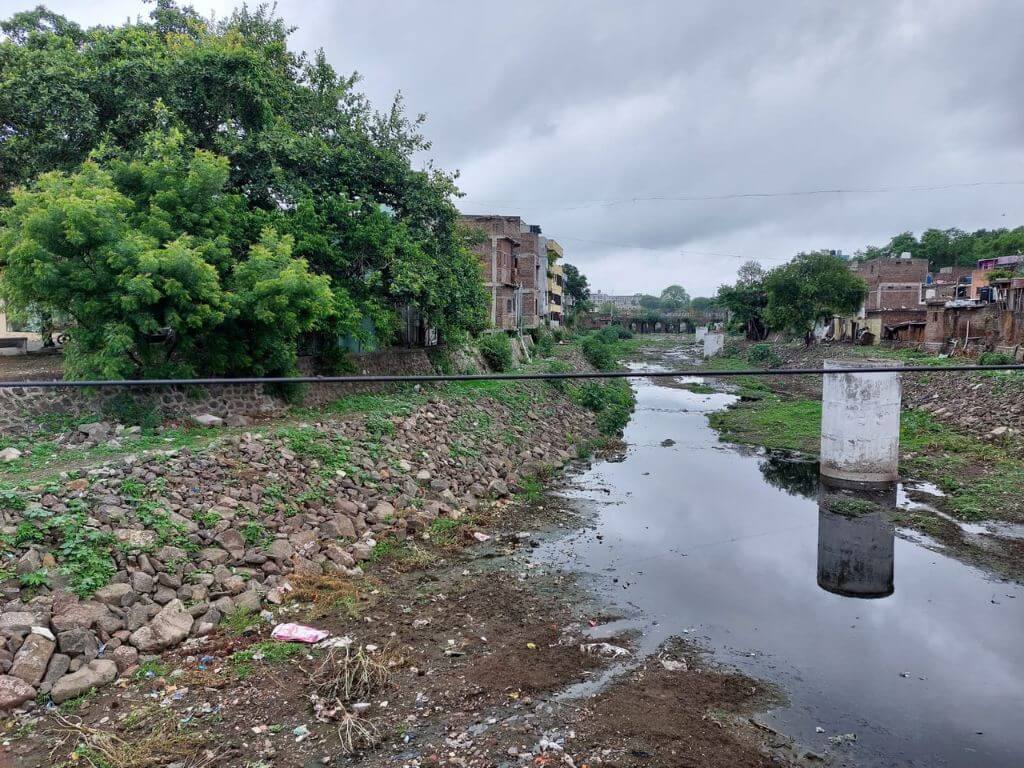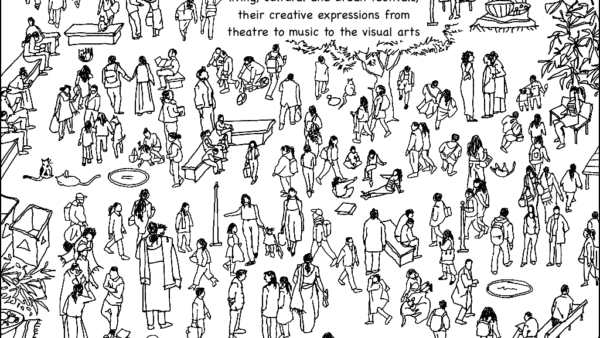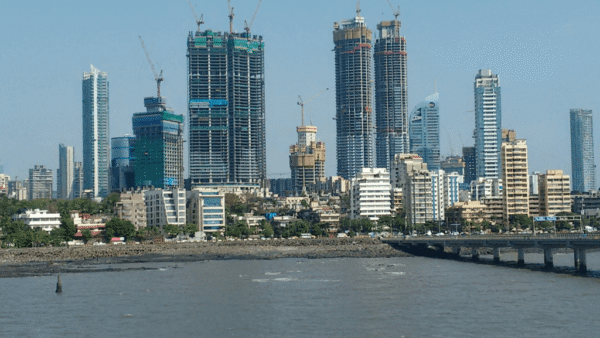The story of the seasonal Kham River which originates from the Jatwada hills and flows through the city of Aurangabad, Maharashtra, before its confluence with the Godavari River or Nath Sagar, is the same as that of most rivers coursing through urban areas: Filthy beyond measure, untreated waste dumped directly, natural ecology and biodiversity hit, and a severed connected between people and their river. However, the similarities end there. The restoration and rejuvenation of Kham River in the last few years have not only given it a new lease of life but also demonstrated the potential of placemaking when done in an ecologically-sound and people-oriented manner.
The Kham stretches over 60 kilometres of urban industrial and rural landscapes. Like most rain-fed rivers in India, it reveals its bare bones in summer and comes alive in the monsoon gushing through the centre of the historic city. Approximately half of the 14 kilometres passing through the city has unregulated sand mining in the river bed, encroachments on floodplains, solid and liquid waste pollution among others. Typically, people of Aurangabad related to the river as a nallah (drain carrying sewage water) though it supported economic activities like dhobi-ghats and patches of agriculture.
As many as 40 per cent of Aurangabad’s residents surveyed in a study were unaware of the existence of the Kham river but 84.2 per cent said they would participate in a river restoration mission. The study identified 86 species of aquatic, semi-aquatic and terrestrial flora though water hyacinth and typha usually found polluted water bodies were missing; the water quality analysis revealed high levels of Chemical Oxygen Demand (COD), Total Dissolved Solids(TDS), very low Dissolved Oxygen(DO) and presence of E. coli and Fecal coliform bacteria; and where the river flows through 30 municipal wards of Aurangabad, it was found to be covered with Municipal Solid Waste(MSW).
There was no doubt that the river was in urgent need of restoration but, as in any Indian city, this was easier planned than done.
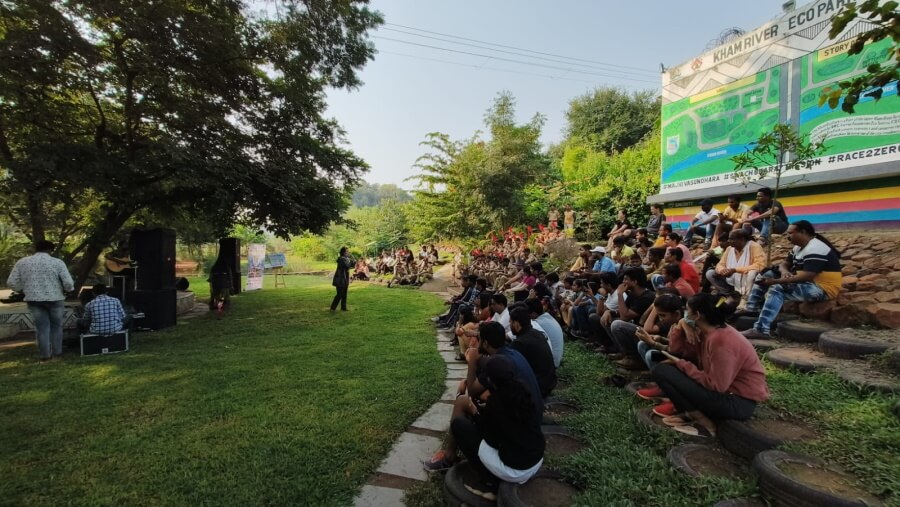
Photo: EcoSattva
Restoration journey
The Kham River restoration mission began with a pilot of 1.5 kilometres downstream in 2016 when a multinational company based in Aurangabad, Varroc Engineering, partnered with the Confederation of Indian Industries (CII) and the Aurangabad Cantonment Board. With in-situ treatment using green bridges and plantations, some results were achieved. However, the constant in-flow of sewage and solid waste dumped in the upstream areas underlined the need for a broader strategy.
Three years later, EcoSattva, an Aurangabad-based social enterprise working to mitigate environmental challenges, was brought on board by Varroc Engineering to broad-based the effort to include the people of the city. The Kham River Restoration Committee was then formally set up with all the stakeholders – primary among them was Aurangabad Municipal Corporation (AMC), then Cantonment Board of Aurangabad (CBA), Varroc Engineering, EcoSattva, and the River Cities Alliance of the National Institute of Urban Affairs (NIUA). The group has continued to grow with more stakeholders and concerned citizens since 2021.
Based on surveys and interviews, three areas of interventions were zeroed in:
- Eco-friendly riverfront development which uses minimal concrete and focuses on restoring the vegetation of the region so that the river remains a public asset.
- Upstream interventions such as intercepting and diverting sewage, door-to-door awareness on solid waste management, integration of thousands of households into the municipal collection system.
- Building a public campaign and citizens’ movement through multiple offline and online media campaigns involving the print media as well as radio and social media to brings the Kham River back into people’s consciousness in a meaningful way.
From nullah to nadi
As in any on-going project, the achievements and successes are tempered by new challenges and issues. What is indisputable is the fundamental shift that has happened – and continues to happen – among the residents of Aurangabad about the river. From seeing it as a nullah emanating a stench, people have woken up to its features as a river and its place in their city.
The achievements have given the Restoration Committee the much-needed impetus to keep going. Among them are the following: More than one lakh square metres have been cleaned of waste and invasive species, ten new ecological riverfront spaces with more than 50,000 trees, the pathways in Eco Park were built from demolition and construction debris from different parts of the city, reduction or complete elimination of more than 150 garbage vulnerable points in the city to directly prevent solid waste pollution from entering the river, mechanical cleaning of the river and pitching of the river banks. Besides, connectivity was built through cycling and walking tracks, and recreational or community spaces created too.
Ecosattva founder Natasha Zarine told Question of Cities, “People living next to the river, parents of children going to the school along it’s banks and those living next to Garbage Vulnerable Points (GVPs) that have now disappeared, are most happy with the results. Next are people who have an interest in environment and the outdoors.”
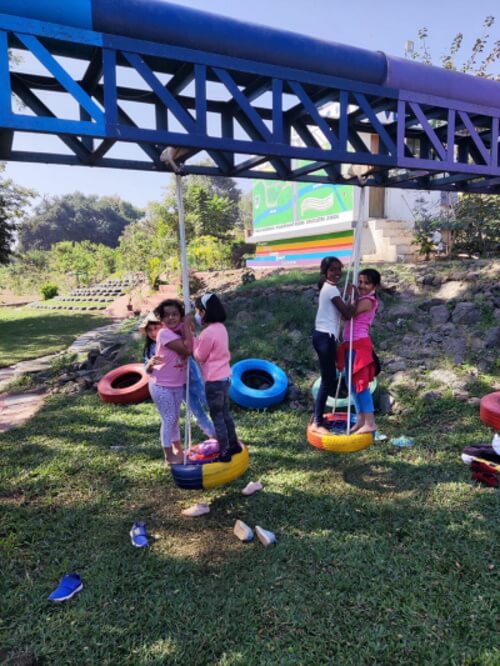
Photo: EcoSattva
What is remarkable is that the Kham River restoration work did not adopt the classic top-down approach where plans are formulated and action taken by those in power. Instead, it ticks off the important aspect of people’s participation in placemaking. So, not only has there been ecological renewal and waste treatment but there has also been public engagement on various aspects of the project, training of sanitation workers, movements to spread awareness as well as effect behavioural change through people’s participation.
Flash mobs were organised by the river banks to focus on waste management, the city’s homegrown band ‘NoB’ wrote the “Kham Song” which turned into a campaign anthem, school and college students were taken for birdwatching and butterfly walks during which experts talk about the river’s biodiversity. Gradually, people have warmed up to the Riverfront and the Eco Park – women’s groups have organised workshops along with clean-up and plantation drives, industrial bodies have a clean-up drive relay every Saturday for which the baton moves from one industry to another, and so on.
Among the landmark moments of the Kham River Restoration project was that Aurangabad became a member of the River Cities Alliance, established by the NIUA and the National Mission for Clean Ganga, to cover more than 50 river cities. The organisation helped prepare the river management plan for Kham River.
“Due to partnerships, the project has been able to witness solutions to the complex issues confronting India’s river cities. The demonstration of intent and impact from the lower-hanging fruit, seen in the Kham River Restoration Mission, sets a context for the complex issues too,” Victor Shinde, Lead, Water and Environment, NIUA.
Criticism as beautification project
The critique comes from people who believe that the mission is focused on the easier issues of beautification than on harder challenges. This is an internal debate among stakeholders too.
Sarang Takalkar, convener of Aurangabad Connect Team (ACT) which works on civic issues, said that despite the restoration work, several houses located at the point where the river enters the city continue to flood. “People obviously also use the river for activities that add to the pollution …Though the Eco Park has a walkway and play areas, people are not able to spend too much time because of the stench,” he remarked.
Residents like Neha Dabale are cautious. “Until last year, the river had not been widened and pitching activities weren’t done because of which water flooded our homes. This year, we didn’t face any problems,” she said. Others like Anjali Chandge noted that there was less garbage littered than earlier and municipal workers had been doing a lot of work. “Since fines were imposed for littering, this space has become clean and the environment feels good.”
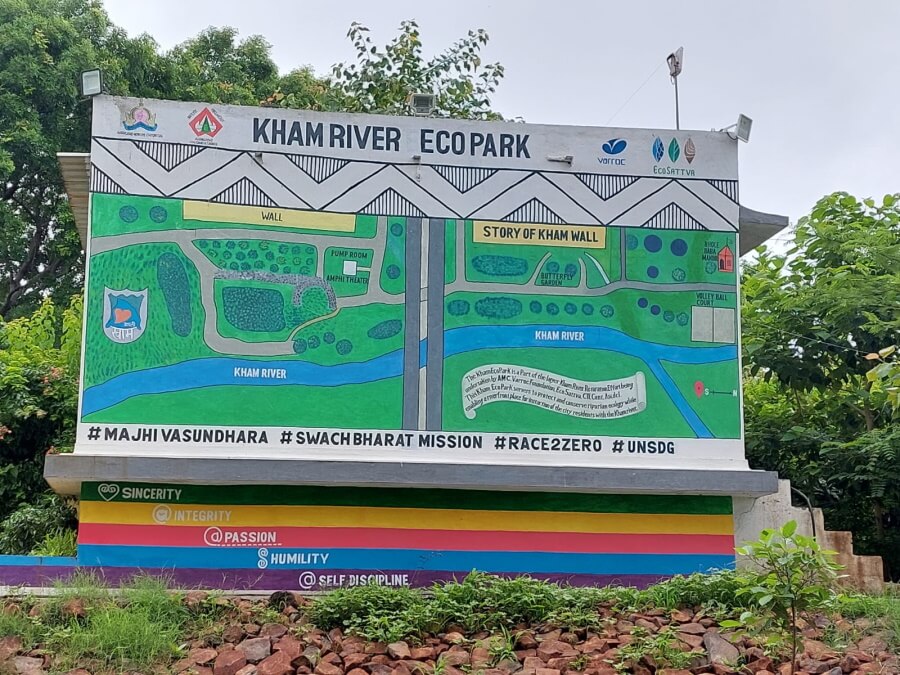
Photo: NIUA
Opinions are divided with some like Takalkar remarking, “The park will be a complete success if the authorities focus on cleaning the river and reducing pollution. Until then, it’s just a beautification project.”
The indispensable official wheel
If the Kham River restoration is earning applause, a fair share should go to the official governance structure which embraced the idea and implemented it.
Even after three years, the 75-member WhatsApp group of stakeholders wake up to a message every morning from Asadullah Khan, assistant commissioner of the Aurangabad Municipal Corporation. It consists of a photo of his team on ground and work plans for the day. As the day progresses, updates come in from other teams – the Gardens team reporting on the status of bridges being barricaded to prevent dumping of waste, the Sewerage department reporting the diversion of raw sewage into the underground network and management of leakages.
The updates range from heart-warming images of peaceful pools of water or a flock of migratory birds interrupted by images of piles of garbage or construction and demolition waste, dead animals or new sources of raw sewage entering the river. Together, the messages and pictures capture the intricate, complex, and difficult journey of the river’s restoration.
“In the 30 years of my service, the Kham River Restoration Mission has been the most challenging but rewarding experience. It has shown me how when intentions are correct and determination is strong, all municipal resources – people, machinery, even waste material – can be harnessed,” said Khan. “In the past two years, we have reused waste poles for lightning, diverted construction and demolition waste to build a porous heritage pathway, brought in discarded stones for pitching and pipes from all over the city thus saving taxpayer’s money.”
Added Somnath Jadhav, additional commissioner, AMC: “The understanding of the strengths and available resources of each partner has been clear, and the resolute focus on creating public assets ensured aligned progress even as day-to-day disagreements and differences in perspectives existed.”
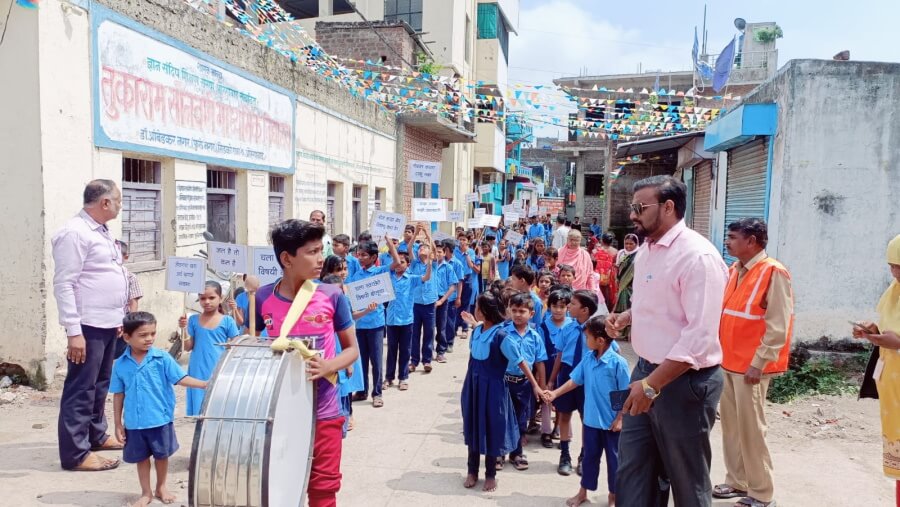
Photo: EcoSattva
Learning on the mission
All stakeholders have gathered many lessons along the way, learning that will be useful for other river cities. Among the lessons are the value of collaborative effort, effective leadership and governance, and optimisation of existing resources.
Collaboration has been the key driver of the mission. The partnerships at the leadership level and on the field have been the catalyst in translating plans into interventions on the ground. The stakeholders have built a ritual of collective discussions between the government and non-government organisations. For example, the AMC drove the first phase of cleaning, desilting and pitching of the banks which was followed by Varroc-EcoSattva piloted a slurry treatment plant. For Solid Waste Management, AMC and non-governmental stakeholders have been working closely to improve the efficiency of doorstep collection and street-sweeping in wards touched by the river.
As the mission evolves, industry and academic institutions have come on board on various occasions, but the biggest takeaway has been the participation of many residents’ groups on Aurangabad whose enthusiastic engagement has contributed to making it ‘Apli Kham’ (Translation from Marathi: Our Kham) rather than a project done by official or corporate agencies.
Aurangabad being the first city upstream of Kham River made it important that the city took the onus of restoring the river. The Kham Restoration mission was embedded into municipal agenda and leadership by former municipal commissioner Astik Kumar Pandey has been central to it. He conducted meetings every Saturday at the Riverfront and merged them into recce riverside walks, clean-up drives and plantations which helped to connect decision-makers to the ground realities. His successor Dr Abhijeet Chaudhari carries on that little tradition. Now, the district collector of Aurangabad, Pandey said, “We harnessed existing municipal resources in addition to public participation and effective partnerships. We were not limited by the tedious processes of acquiring specific funding.”
All work carried out since 2020 has leveraged existing or available municipal resources – without supplementary government funding – bolstered by funds from Corporate Social Responsibility channel of Varroc, and contributions from residents and local associations. With most such projects hitting a roadblock because of funding problems, the Kham story serves as a reminder that public funds remain the best resource for placemaking.
A dash of imagination has helped too. The stones needed for pitching the banks were secured from another part of Aurangabad where excavation work was underway, thus acquiring hundreds of tonnes of good quality basalt for free. Discarded paver blocks were recycled for some recreational areas. A Special Task Force has been created from the existing staff to maintain various interventions completed.
The road (river) ahead
At the start, only 15 per cent of the entire river length was taken up considering that restoring a river is a complex and sometimes befuddling process. Stakeholders are coming to grips about what they know and do not know. As Zarine remarked, “Thought and action go hand in hand and sometimes we learn more by doing than by studying or waiting for the perfect information,as was amply demonstrsted by our municipal commissioner. What action also does is make the vision tangible. Every new riverfront space that has been developed, every garbage vulnerable point that has been reclaimed, gives people an opportunity to see what the Kham could – and should – be like. Of course, we must capture the data from the field and continue to improve and standardise designs and plans.”
Over the course of two years, the Kham River Restoration project has seen significant progress. It has received recognition as a growing network of partners amplify the impact; Aurangabad has quietly shown that placemaking with a purpose can make a difference to the entire city. It holds significant lessons for river cities.
This reported essay was helped with inputs from Ishleen Kaur, Senior Environment Specialist working on the Water and Environment vertical at NIUA; Gauri Mirashi, co-founder of EcoSattva; and Suhita Dugar, programme manager, Water Body Restoration at EcoSattva.
Jashvitha Dhagey developed a deep interest in the way cities function, watching Mumbai at work. She holds a post-graduate diploma in Social Communications Media from Sophia Polytechnic. She loves to watch and chronicle the multiple interactions between people, between people and power, and society and media.
Cover photo: NIUA

